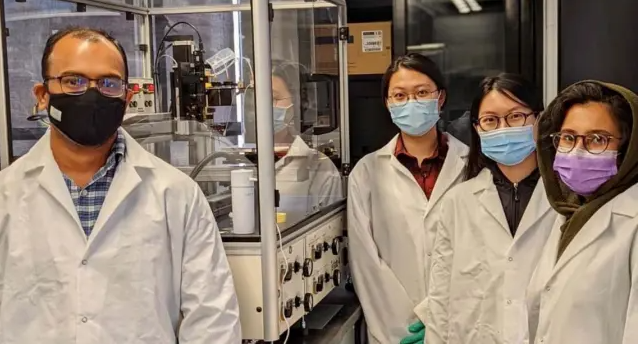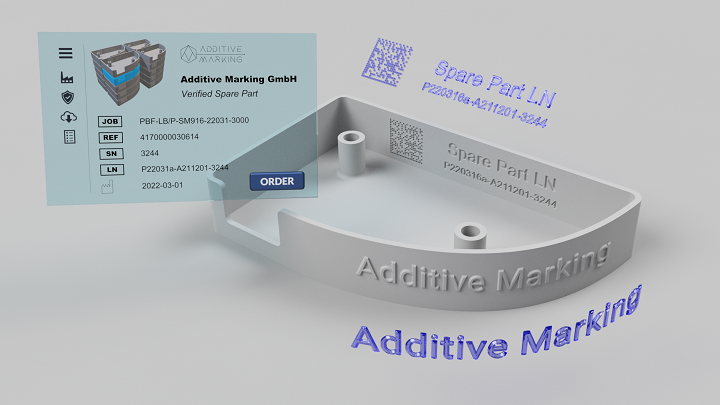Additive Marking has reported a successful investment round, while PharmE3D Labs received federal funding for 3D printed contraception research. This starts off today’s 3D Printing News Briefs, and then we’ll move right into the VA’s work pioneering new medical 3D printing uses for prosthetics care. Together, Starfleet Innotech and Luyten will make their entrance into the $19 million global 3D printed construction market. Finally, a glass manufacturer is 3D printing spare parts using Sintratec’s solution.
Additive Marking Speeds Up Growth with Investment Round
Startup Additive Marking GmbH, together with the HAVER Business Angel Group and Archimedes New Ventures GmbH, announced the closing of a successful six-digit financing round to help accelerate its growth. Speaking of growth, the market for 3D printed products isn’t slowing down, which means that the need for secure solutions to protect and identify components is also growing. Additive Marking offers a patent-pending process that can generate machine-readable codes on a product during the 3D printing process, which makes it traceable and tamper-proof. Additionally, helpful information can be linked to the component as well. This method is more reliable and economical, and faster, than other direct marking methods like engraving, needle embossing, and laser marking. With this additional investment, the company will be able to increase its sales activities and grow its project and consulting capacities.
Additive Marking CEO & Founder Dr. Ulrich Jahnke said, “In addition to the fresh capital, which enables us to open up new markets, we benefit in particular from the know-how within the circle of shareholders.”
UT Austin’s PharmE3D Labs Receive Federal Grant for 3D Printed IUDs

Some members of the IUD project team: Dr. Jaidev Chakka, Anqi Lu, Jiawei Wang, and Dr. Niloofar Heshmati.
The Pharmaceutical Engineering and 3D Printing Labs (PharmE3D) at the University of Texas at Austin College of Pharmacy announced that it will be developing personalized 3D printed non-hormonal intrauterine devices, or IUDs, thanks to a federal grant from the United States Agency for International Development (USAID). The project is in collaboration with Contraceptive Research and Development (CONRAD), which was set up under a cooperative agreement with Eastern Virginia Medical School (EVMS) and USAID, and the goal is to increase global access to effective, long-term contraception, while at the same time reducing some its bad side effects. Commercial IUDs, while extremely effective against pregnancy, can increase cramping and menstrual flow, which results in roughly 10-13% of users having them removed within a year. That’s why PharmE3D Labs wants to use an optimized 3D printing process its researchers developed to produce personalized IUDs, which will hopefully get past some of these issues.
“This USAID grant has potential to make a significant impact on women’s reproductive health in the developing world. Our collaboration with CONRAD and EVMS has been fruitful at the further development of 3D printing technologies to tackle global health issues and healthcare access,” said Dr. Mo Maniruzzaman, an assistant professor in the college’s Division of Molecular Pharmaceutics and Drug Delivery and the leader of PharmE3D.
VA Announces New Medical 3D Printing Applications for Prosthetics
Development teams in the Department of Veterans Affairs have introduced new medical 3D printing applications that will help provide advanced prosthetics care. This has long been a priority in the agency’s medical device research, and represents one of the earliest examples of the VA merging research goals with its 3D printing network. At the recent FDA 3D Printing Virtual Workshop, technologists from the Veterans Health Administration and joint Defense Department/VA 3D Printing Consortium showcased some 3D printed prosthetic device prototypes, many of which were designed for veterans who suffered either partial or total limb loss at a younger age but still want to remain active and mobile, doing physically demanding things like lifting weights. Continuity of care was also considered, as these veterans will continue to need prosthetics help as they age, as well as customized and adaptable prosthetics.
“In the military, you’re dealing with a different type of patient. You have these young, active individuals that want to take part in complex activities. They just don’t want to be able to walk down the street. They want to be able to run, they want to be able to climb mountains, climb rock walls, play ice hockey, play sled hockey, whatever they want to do,” explained Peter Liacouras, director of the joint VA-DOD 3D Medical Applications Center at Walter Reed.
“These amputees within the DOD then go on to the Veterans Affairs health care system, and you want to care for these amputees over time. It’s not just a one-day event, you have to care for these amputees for the rest of their lives. Some of these individuals are very young — 20s or 30s — and they want to take place in these complex activities for many more years. So you have to look at all these different applications.”
Starfleet Innotech & Luyten Partner to Enter 3D Printing Construction
Moving on, global investment holding company Starfleet Innotech, Inc. (SFIO) is partnering with additive construction equipment and technology manufacturing startup Luyten in an exclusive agreement to enter the $19 million global 3D printing construction market together. Premiere wellness tourism brand Moraya leads SFIO’s real estate division, and Luyten will now be a big part of championing its mission of wellness through innovation. As part of this strategic partnership, the startup will provide the necessary materials and construction machinery to grow SFIO’s real estate developments in the Philippines—where many Moraya developments will go—in order to build a more equitable, sustainable future for community living. SIFO will have exclusive distribution rights to Luyten’s 3D printing systems in the Philippines, and projects that it will sell at least 50 units of concrete 3D printers to other organizations and developers in the next year. Another result of the partnership will be 500 low-cost housing units built across the Philippines in the next two years.
“Our partnership with Luyten stems from our commitment to invest in the futures of the industries we operate in. Joining Moraya’s divisional ecosystem, Luyten will play a key role as an enabler for our various real estate initiatives. Their affordable, sustainable offerings will allow us to build exciting projects that champion both the new communities we hope to build, as well as the existing communities we hope to serve,” said Starfleet Innotech’s CEO Jeths Lacson.
LiSEC Using 3D Printing to Advance its Glass Processing
Finally, all-in-one flat glass processing and finishing solutions provider LiSEC is using 3D printing to produce its machinery, including components, prototypes, and spare parts. Last year, the Austria-based company invested in an S2 selective laser sintering (SLS) 3D printer from Sintratec, with its better surface finish, in order to meet increasing demands at the company’s factory. The company uses the S2 almost daily to print medium-sized production parts and prototypes out of PA12; one example is a bending test rig, which is used to measure the force needed to deform an aluminum frame. Benjamin Kaubeck, who leads the apprentice workshop at LiSEC’s headquarters, and his team of instructors are convinced that the industrial 3D printing solution is a great idea.
Kaubeck said, “Our vision is to stay at the cutting edge of technology with apprentice training and to establish a department with ever new technologies.
“With the SLS process, we produce a lot of spare parts, which allows us to support our customers faster – and that is our main goal.
“We are positively surprised by the Sintratec technology and very enthusiastic about the cylindrical build volume as well as the handling of the machine.”
Subscribe to Our Email Newsletter
Stay up-to-date on all the latest news from the 3D printing industry and receive information and offers from third party vendors.
You May Also Like
3D Printing News Briefs, April 13, 2024: Robotics, Orthotics, & Hypersonics
In 3D Printing News Briefs today, we’re focusing first on robotics, as Carnegie Mellon University’s new Robotics Innovation Center will house several community outreach programs, and Ugogo3D is now working...
Rail Giant Alstom Saves $15M with 3D Printing Automation Software 3D Spark
3D Spark has entered into a three-year deal with the rail giant Alstom. Alstom, a transport behemoth with annual revenues of $16 billion, specializes in the manufacture of trains, trams,...
Meltio Expands Global Reach with New Partnerships in the Americas and Europe
Spanish 3D printing manufacturer Meltio has expanded its sales network across the globe. With the addition of three new partners in the United States, Brazil, Argentina, and Italy, Meltio aims...
3D Printing Webinar and Event Roundup: April 7, 2024
Webinars and events in the 3D printing industry are picking back up this week! Sea-Air-Space is coming to Maryland, and SAE International is sponsoring a 3D Systems webinar about 3D...



































